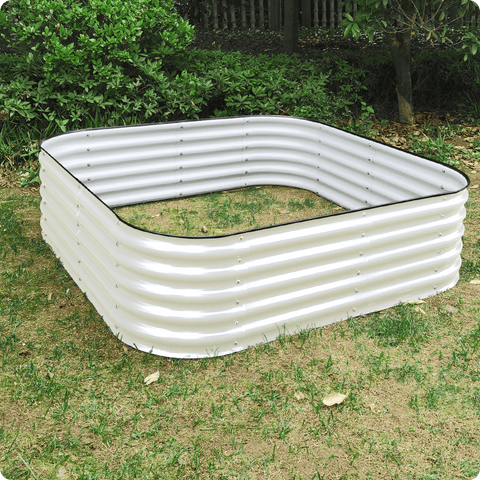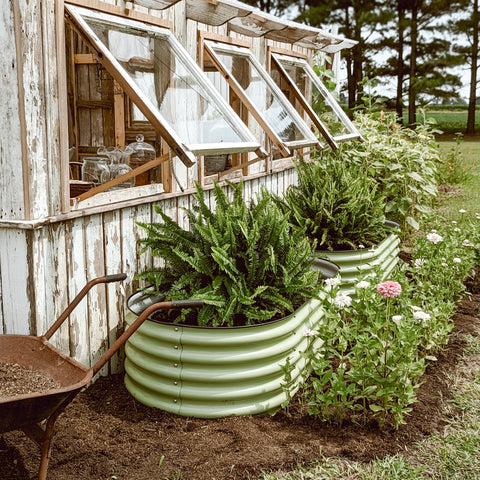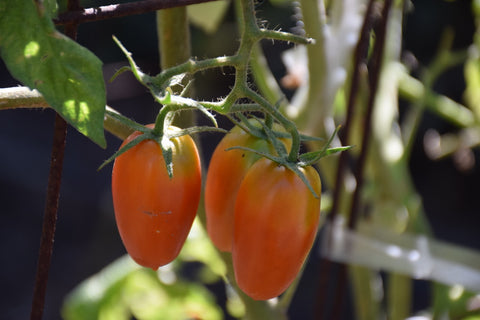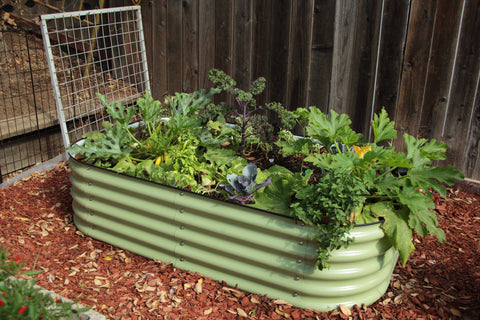Raised Garden Bed Related Knowledge- Apple Scab
Apple scab (Venturia) is one of the most economically destructive diseases for apple growers worldwide. In Australia and parts of Asia, the disease is also more commonly known as black spot. This fungal pathogen thrives in cool temperatures and humid spring weather. Although the geographical scope of apple scab is very wide, and apples are planted all over the world, the disease is the most serious in temperate climate. Here's what Olle is going to talk about.
The characteristic of apple scab is that the host tree leaves leaves leaves, which will significantly weaken its overall vitality and fruit yield. In addition, apple scab makes fruits unsalable because it can cause fruit cracking and make plants suffer from secondary infection of other pathogens or pests. This pathogen causes more damage than any other plant disease that affects apple varieties. In addition to apples planted for fruit, apple scab will also affect ornamental crab apple trees and mountain ash. For ornamental plants, their fallen leaves will have a negative impact on the overall appearance of these cultivation spaces.

The main method of controlling this disease is to use cultural and hygienic methods, combined with some fungicides for commercial growers. The timing of the application of bactericides is crucial, because bactericides prevent diseases, not cure them. Finding the best organic fungicides that do not adversely affect the health of trees or beneficial insects remains a challenge.
What is apple scab?
Apple scab is caused by fungal Venturia. This disease causes the leaves, stems, flowers and fruits of the affected plants to lose their leaves and become diseased. Asexual reproduction and asexual reproduction. The term "inaequalis" in its scientific name refers to the unique and unequal "footprint" shape of its sexual spores or ascospores.
Life cycle of apple scab
The fungus of apple scab overwinters on the fallen leaves and fruits of the infected trees. In late spring and early winter, the fungus produces black pustules, and starts the disease cycle by producing and releasing sexual spores (ascospores). The beginning of the disease cycle of sexual reproduction coincides with the host tree breaking the domanche. Wind and rain carry these spores to infect newly emerging leaves and nearby trees. Scab lesions begin to appear within 10 days after infection, and there is only one sexual reproduction cycle every year.
During the summer, V Inaequalis spores repeatedly on the leaves and further spreads the disease to other parts of the plant and its neighbors. These secondary spores are the result of asexual reproduction of conidia. Conidial clusters give the lesion a velvety brown or olive green appearance. About 100000 conidia can be found on one lesion!
Both types of spores require water to germinate, and leaves or fruits must be kept moist for several hours before infection can occur. The length and severity of the infection period of apple scab and the development of the disease depend on temperature, humidity, the health of the host tree and the age of the leaves. The spread speed of pathological changes in some apple varieties is slower than that in other varieties, which provides them with a certain degree of resistance to this pathogen.

Symptoms of apple scab
The disease first appears at the base of young leaves in early spring as vague and undefined patches. Many people mistakenly think that apple scab is a mold, or even just a natural hair on the leaves. However, over time, the villi become olive green spots, and then more pronounced brown lesions, eventually turning them yellow and causing the leaves to fall. Seriously infected leaves and fallen leaves are a key symptom of the disease, which adversely affects the health and growth of infected trees, especially newly transplanted young trees.
Lesions can also occur on fruits, although developing fruits are unlikely to fall like leaves. With the passage of time, small lesions show clear boundaries and cork appearance. The lesion may cause the fruit to crack. The primary infection of apple scab can open fruit or leaves until new infection of other diseases or pests. Sometimes, late season fruits will not show obvious symptoms of apple scab before storage.
Another apple fungal disease, cedar apple rust, can also cause lesions on infected leaves. However, these lesions are yellow with a dark center. The center of darkness is where you can see the fruiting bodies of fungi. The diseased leaves of the host plants affected by apple scab will look very different.
Infection can also lead to lesions and openings in branches. These openings are the entry points of other diseases such as apple canker fungus.
Which plants are affected by apple scab?
Many apple and crab apple trees (Malus) are susceptible to this scab. To be specific, popular varieties such as Macintosh, Cortland and Hanigord are very likely to be infected.
Apple scab also affects hawthorn (Crataegus), hawthorn (Crataegus) and Cotoister (Cotoister). A similar fungus, Pirina Venturina, infects pears (Pirous Commune).
Control apple scab
As with many diseases, effective management of this scab requires a combination of technologies, including variety selection, chemical and cultural control, and appropriate health technologies. The good news is that apple scab rarely kills trees, unless very young trees are experiencing multiple major defoliations. Apple scab infection may take 1-2 years to be controlled, once it is controlled in your orchard or garden.

Because apple scab is a fungal disease, it thrives in humid conditions. Moist leaves are necessary for the spread of apple scab. Some cultural practices that can help include choosing a planting site that has at least six hours of sunshine every day, so that apple leaves have time to dry. Do not use overhead watering to avoid unnecessary wetting of leaves. In addition, pruning apple trees can improve airflow around leaves and fruits. Remove the suction cups and nozzles to keep the roof open. Pruning is also a commonly used technique to improve the overall vitality of fruit trees and increase the size of fruits.
In the management of apple scab, hygiene is very important, and the spread of fungal spores should be minimized to protect healthy trees. If possible, remove the fallen leaves, which can be composted. If it is impossible to rake up all fallen leaves, try to speed up the decomposition of leaves by covering or flail pruning, and add nitrogen sources, such as 5% urea solution, to speed up the process. Urea is applied in late autumn and after the last leaf falls to avoid stimulating the growth of more leaves on the tree in winter. This may make trees more vulnerable to winter damage.
Organic apple growers plant resistant varieties to limit the influence of apple scab and use chemical control. However, many non organic growers will use sulfur fungicides to manage apple scab. Time is of the essence, and the success of the growing season depends on early detection of problems. In early spring, start spraying fungicide to the green tip of the bud, when healthy tissues become vulnerable to pathogens first. Spray according to the instructions on the bottle for 7-10 days until the petals fall. The bactericides commonly used by home growers act as protective barriers around plant surfaces, which makes it necessary to apply them continuously, especially after wet periods. It is important to read the labels of fungicides because certain chemicals should not be used for a period of time before harvest.
Ornamental crab apples usually do not require fungicides. If the ornamental crab apple leaves leaves leaves heavily, you may need to use a fungicide specifically marked for ornamental purposes.
For farmers and researchers all over the world, it has always been a great challenge to find appropriate organic fungicides. Only sulfur and lime sulfur are approved for organic use. However, the negative effects of lime sulfur on apple trees have been widely recorded. In particular, the use of lime sulfur will cause the fruit to fall, and the plant toxicity will burn the fruit, thus reducing the fruit quality, the reddish brown leaves, and the overall photosynthesis of plant tissue. According to records, elemental sulfur will harm beneficial insects, such as predatory mites, and help control other pest populations.

Although family gardeners may be able to apply small-scale fungicides to young trees, you may need to contact a certified arborist to spray large mature apple trees, especially if you have many apple trees. Please contact your county's promotion office for more information and suggestions.
Prevention of apple scab
There are more than 25 anti scab varieties, including honey fungus, free and cranberry. There are also many resistant varieties of ornamental crab apple trees, including Don Wyman, grassland fire and snow drift. Planting resistant cultivars is a good way to prevent apple scabs in gardens or orchards. Although some varieties are resistant to apple scab, they may still be vulnerable to other apple diseases, so there is no "panacea".
common problem
Q: Can you eat apple scab?
A: Fruit with apple scab can still be eaten, although it is usually not marketable. You may not want to eat infected fruits with apple scab, because the scab will cause wounds in the fruit tissues, exposing them to other diseases and secondary infections of pests. Apple scab reduces the quality of fruit and is a serious disease of global commercial growers.
Q: When should I spray the apple tree scabs?
A: The fungicide can be sprayed on the apple tree at the beginning of the growing season, when the leaves just appear. Be sure to follow the instructions of the fungicide spray to best prevent apple scab.

Q: Why does my apple scab?
A: Apple scab, Venturia, is a fungal disease transmitted by the spores of apple scab. Many apple varieties are vulnerable to the disease, and humid weather conditions will also aggravate its spread.
Q: When should apple trees be pruned?
A: Follow spacing guidelines when transplanting and do not overcrowd plants. Prune apple trees during winter and dormancy. Ensure that all garden tools are disinfected before pruning and between plants to minimize the spread of disease.
Q: Which fungicide is most suitable for apple scab?
A: The fungicides that can be used to treat apple scab include capsaicin, Mancibu, copper based fungicide products (such as copper hydroxide), sclerotinia butan and terbuconazole. These are not organic fungicides. The only fungicide approved for organic use of apples is sulfur and lime sulfur. The application of bactericides must be carried out before infection. If you have a history of high disease stress and have many previously infected trees, you may need to use this apple scab management technology.
Q: Can neem oil treat apple scab?
A: No, neem oil will not be effective in treating infected trees. A study was published in the journal Hott Science to study organic substitutes for traditional fungicides to prevent apple scab. The researchers compared traditional fungicides with neem oil and Bacillus subtilis (BS). They found that neem oil treatment did not help apple scab infection, and may actually have a negative non target effect. BS actually caused more insect damage than the control tree.
